.
Bonjour, Marie-Agnès, Jean-Claude et Janice! Ca va? – How are you today? 🙂
.
I wonder whether our readers have guessed that, as well as sending these occasional
Letters from Scotland, Margaret and I correspond regularly with you by email? We write in English, Marie-Agnès and Jean-Claude in French, and Janice often alternates between the two languages.
I enjoy being reminded of French words I’d rarely come across since schooldays; my old French teacher would wisely give us little groups of words to be written together in our notebooks, to make clear the differences and to help us remember! For example, «une librairie» is a bookshop (or a publishing house); «une bibliothèque» a library (or collection of books; or even a set of bookshelves!) Yes, Marie-Agnès, we do have upstairs
une bibliothèque tournante – a revolving bookcase. It’s a small one, but it holds a surprisingly large number of books.
.
Two years ago, Marie-Agnès, in one of Scotiana’s early posts, you confessed to the whole world your – and Janice’s – passion for books! 🙂 (
From Mitchell Library to Loch Croispol Bookshop .. )
‘Books, Books, Books! What insatiable bookworms we are, Janice!’ it began .. ..
.

The Mitchell Library in Glasgow, Scotland - Source Wikipedia
.
And it’s in the Mitchell Library, Glasgow – the largest public reference library in Europe – that our tale starts today; for here is kept the precious and beautiful Leningrad Album, a work of art rather than a mere book, whose story Margaret tells below. This year sees the 70th Anniversary of the horrific events of the Siege of Leningrad in the Second World War, events which are now passing beyond living memory.
.
With his pathological hatred of the Slav people, Hitler despised the Russians; his troops fought them with unparalled viciousness and brutality. Finding Leningrad strongly defended, the Nazi leader coldly calculated that it would be more efficient to starve the city’s population to death than to feed them as prisoners. Historians estimate that by the time the Siege was lifted (28th January, 1944) a million and a half people had died at Leningrad, civilians and armed forces, of hunger, malnutrition, wounds and disease. (This figure far exceeds the combined total of British and American Second World War dead.)
.
These are events to make one weep. But Margaret’s story today is ultimately one of hope, of the humanity that triumphed amid such appalling suffering. With the last vestiges of their strength, some of Russia’s most accomplished artists struggled to create that extraordinary gift, the Leningrad Album. Its pages were of thin card, each measuring 300x400mm, and adorned with beautiful watercolours and engravings.
.
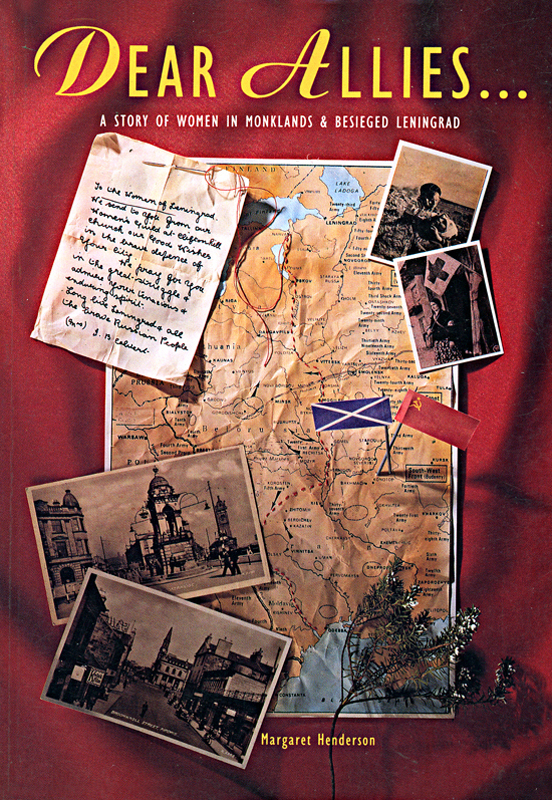
Dear Allies by Margaret Henderson - Monklands District Libraries 1988
Margaret’s telling of the story of the Leningrad Album is drawn from her short book which came out in 1988 (under her professional name, Margaret Henderson): Dear Allies : A Story of Women in Monklands and Besieged Leningrad. (Published by Monklands District Libraries. Paperbound book, 134pp, 210x148mm, ISBN 0946120218. A few new copies are still available from the Libraries Service at the original price of just £5.30; details are given at the end of this post.)
………………………………………………………………………………………………………………………………………..
.
On 22nd June 1941 Adolf Hitler unleashed against the Soviet Union Operation Barbarossa, a military invasion on a scale unknown in the history of human conflict. A mechanised and armoured horde of three and a half million men of the German Wehrmacht with their Axis allies poured across the frontier while planes of the Luftwaffe rained down bombs on the sleeping border towns. More than 1000 Soviet planes were destroyed before they could become airborne, such was the speed and devastating efficiency of the Blitzkrieg, the ‘lightning warfare’ perfected by the Germans.
.
It was 5.45 a.m., British time – a Sunday morning – when Dr Goebbels, the Nazi Minister for Propaganda, read the Führer’s proclamation : ‘The greatest march the world has ever seen is taking place.’
.

Operation Barbarossa: the German invasion of the Soviet Union - 21 June 1941 to 5 December 1941 - Source Wikipedia
.
The German attack on the Soviet Union was three-pronged. Army Group South was to aim for the oilfields and fertile farmlands of the Ukraine. Army Group Centre’s objective was the capture of Moscow. The thirty divisions of Army Group North, supported by 430 aircraft of the First Air Fleet were to over-run the Baltic states and enter Leningrad, the city Hitler called ‘the breeding centre of Bolshevism.’
.
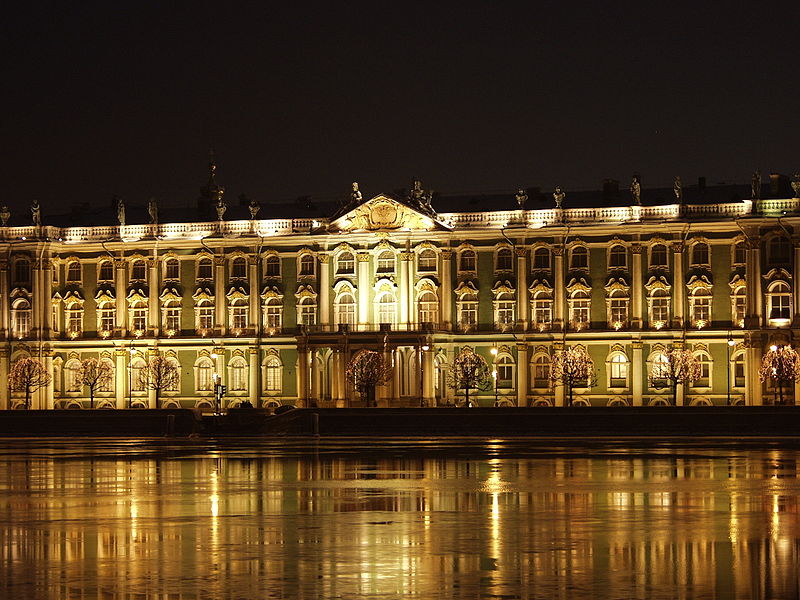
Leningrad Ermitage by night, Russia - Source: Wikipedia
.
To the people of Leningrad, their city was the cradle of three workers’ revolutions and the city named after Lenin, where the founder of the Soviet state had announced the birth of the world’s first Socialist society in 1917. Constructed as Tsar Peter the Great’s dream of a capital city, Leningrad had been cherished and embellished for more than two centuries. It was no longer the administrative capital, but it remained the brilliant centre of culture and learning it had been since its foundation in 1703.
.

St Petersburg Church of the Savior on Blood, Russia - Source: Wikipedia
“We shall be in St Petersburg in three weeks,” Hitler had announced, deliberately using the old Tsarist name. “The city will be erased from the face of the earth.”

Soviet World War II poster: " We will defend the city of Lenin!" - Source Wikipedia
.
As Army Group North came closer, Leningraders feared for their lovely city as much as they feared for themselves and their children. An even higher percentage of civilians in Leningrad than elsewhere in the Soviet Union volunteered for the Opolcheniye – the People’s Army. Five days after the German invasion of Russia, the city authorities ordered the people of Leningrad to start constructing defences around the city alongside soldiers of the Red Army.
.

Women building defences in the streets of Leningrad - "Dear Allies" by Margaret Henderson-Monklands District Libraries 1988
Carrying pickaxes and shovels they left the city in their thousands, women, old men, boys and girls. By the end of July almost a million citizens were helping the Red Army units to prepare for the invader by building hundreds of miles of triple defence lines. As it turned out, the Leningraders had a matter of weeks for the Herculean task of digging by hand a total of almost 16,000 miles of anti-tank ditches, constructing 5,000 firing-points and laying over 400 miles of barbed-wire defences.

Anti-tank barriers on the outskirts of Leningrad "Dear Allies" by Margaret Henderson - Monklands District Libraries 1988
.
By the middle of August, Russian resistance had forced Army Group North to a halt on the edge of Leningrad. The people were now back in the city, working night and day on anti-tank barricades in the streets and setting up firing points in their own homes. Leningraders were determined that their most treasured public buildings would never fall into German hands and laid mines in them, to be detonated if the city should be over-run. In fact, not a single German soldier was ever to enter Leningrad except as a prisoner of war.
.
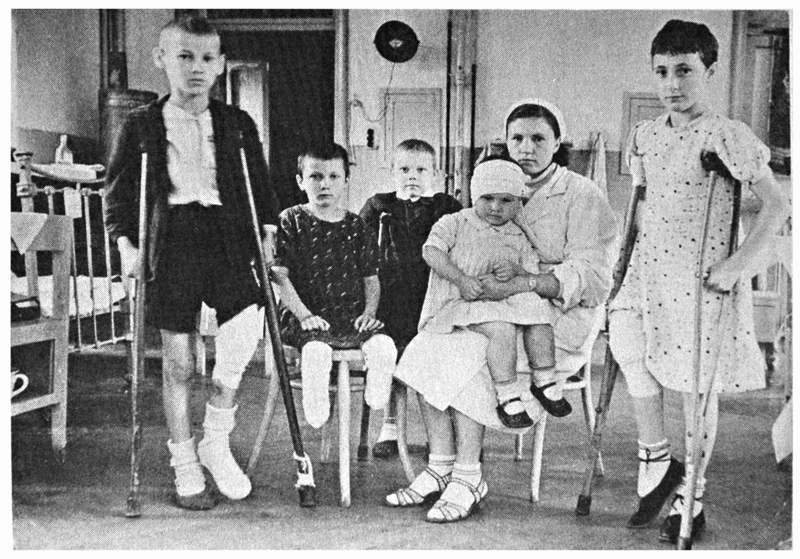
Children of the War- 'Dear Allies' by Margaret Henderson -1988 Monklands District Libraries
.
In early September Leningrad’s last link with the outside world was severed, when the railhead at Mga fell to the enemy. Almost three million people were trapped. On 9th September German bombs destroyed the Badaev warehouses which contained most of the city’s food supplies. The authorities responded by organising ‘food search groups’. Women, children, the sick and the disabled visited empty flour mills, shaking out grains from discarded flour sacks; in breweries spillages of malt were located below floor-boards and scooped up in containers. At the docks a consignment of 2000 tons of sheepgut was seized upon and made into an evil-smelling meat substitute. Members of a search party who came upon some grain under an enormous empty storage tank pulled neighbouring tanks from their foundations, an operation which yielded 389 tons of grain.
.
At home, housewives cut buttons from clothes and dissolved them to make soup. Pancakes were made from sawdust mixed with wallpaper paste, leather was boiled and tree-bark was served as stew. Glycerine and carpenter’s glue became ingredients in bizarre new recipes.

Women in Leningrad obtaining water in the street in 'Dear Allies' by Margaret Henderson - Monklands District Libraries 1988
.
As the winter drew near, temperatures dropped, reaching 30 degrees below zero. Women had to fetch water from the frozen River Neva using children’s sledges for the pots they were too weakened by hunger to carry. The central power station was an early target for German bombers, cutting off domestic heating and lighting. Radios worked only intermittently, supplemented by wall newspapers and public address systems. Bus and tram services had ceased.
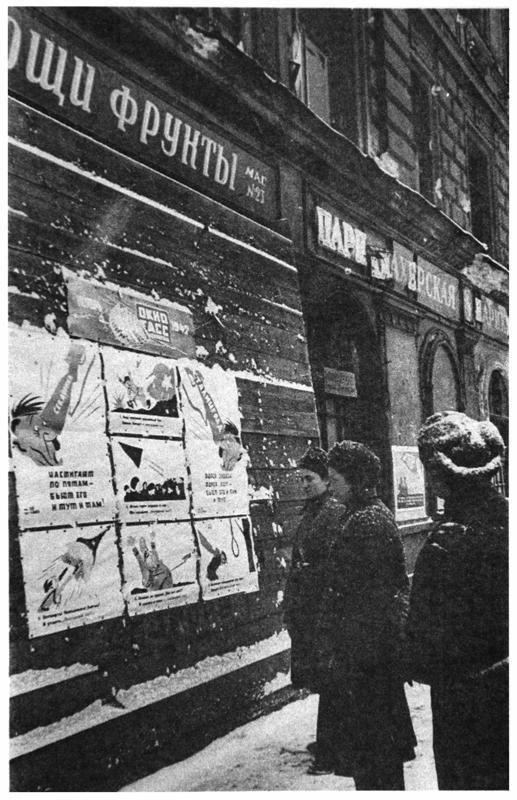
Reading Wall Newspapers in 'Dear Allies' by Margaret Henderson -1988 Monklands District Libraries
.
On the evening of the launch of Operation Barbarossa, Winston Churchill had broadcast an emotional speech on the BBC. His words must have surprised listeners more familiar with the anti-Communist rhetoric he had employed since the Revolution of 1917, when he had talked of ‘strangling the infant Bolshevism in its cradle.’
.

Sir Winston Churchill - WWII - Source Wikipedia
.
.
“I see advancing in hideous onslaught the Nazi war machine. We shall give whatever help we can to Russia and the Russian people. We shall appeal to our friends and allies in every part of the world to take the same course .. .. .. Russia’s danger is our danger and the danger of the United States, just as the cause of any Russian fighting for his hearth and home is the cause of free men in every corner of the globe.”
.
As far as the British people were concerned, Mr Churchill’s exhortations were hardly necessary. People of all social classes and political persuasions were united in grief for the agony of the Soviet Union and in gratitude for the brave resistance of the people and the Red Army. All over Britain groups were being set up to raise funds. One of the largest was the British Red Cross for Russia Fund, headed by Churchill’s wife, Clementine.
.
First reports of the appalling hardship suffered by the citizens of Leningrad touched a special chord in our hearts. In Airdrie and Coatbridge, adjacent steel-manufacturing towns close to Glasgow, contributions to funds for Russia were generous. In an area where unemployment had been high since the Depression, many men, after years out of work, had found jobs in factories converted to war production; and many women were in paid employment for the first time in their lives.
.
In Airdrie, the Russia Today Society was well supported by mothers with young children who could not directly help the war effort by working in local munitions factories. On the committee of the Society was Mrs. Agnes Maxwell who had a ten-year-old son, Alex, and a daughter, Jenny, four years of age. She also looked after an evacuee from Birmingham, a boy about the same age as Alex. In October 1941 the committee met in an endeavour to find some way of expressing their admiration and sympathy for the people of the besieged city of Leningrad.
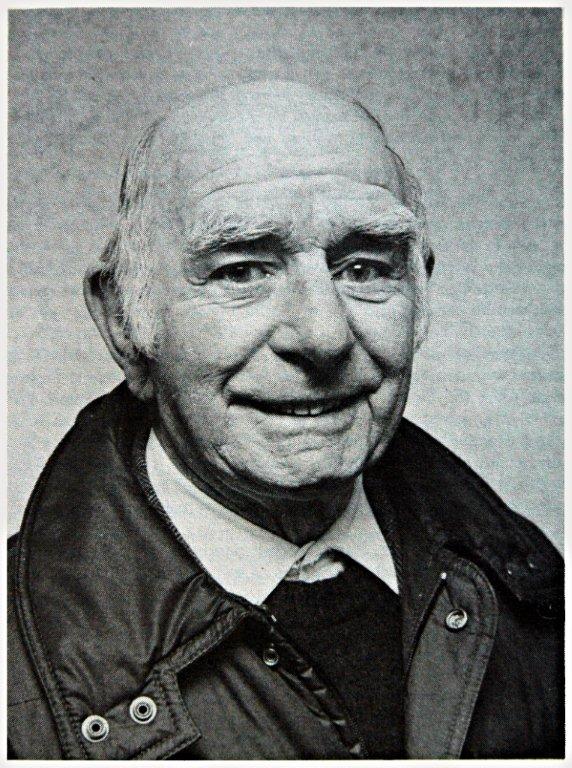
Harry Walker 'Dear Allies' by Margaret Henderson - Monklands District Libraries 1988
The late Harry Walker attended the committee meeting on that auspicious evening :
.“The eyes of the world were on Leningrad. We were all aware of the tremendous contribution of women volunteers defending the city, night and day, against the fascist forces.We had a large and enthusiastic women’s section in the Russia Today Society. All the women were deeply affected by what they had been hearing about Leningrad. They were desperately anxious to do something to feel part of the vast struggle that was taking place. The plight of Leningrad was the sole topic of discussion at that meeting. We agreed to act immediately, for we could not know how long the besieged city would hold out, the situation was so grave. We decided that a collection of women’s signatures should be made in both Airdrie and Coatbridge and somehow sent to the women of Leningrad with a message conveying our admiration and feelings of solidarity.”
.
That night six office bearers of the Russia Today Society composed the message :

To Women of Leningrad 'Dear Allies' Margaret Henderson -1988 Monklands District Libraries

To Women of Leningrad 'Dear Allies' Margaret Henderson -1988 Monklands District Libraries
“To the heroic women of Leningrad, from the women of Airdrie and Coatbridge:
We wish to express our boundless admiration for the heroic struggle you are waging against the barbaric armies of Nazi Germany, the enemy of all freedom-loving people. Our hearts go out to you in this, your hour of supreme agony and triumph, but we are confident that the resolution and self-sacrifice shown by you will shatter the fascist armies. We solemnly pledge ourselves to do everything possible to rouse the women of Britain in this fight and will leave nothing undone that will ensure the quickest and most effective aid being given to your country. Your fight is our fight and we shall not fail you or be unworthy of your great sacrifice.”
.
The committee’s next decision was to set up a Housewives’ Organisation in Airdrie and in Coatbridge, composed of women volunteers who would collect signatures and messages of goodwill in both towns. Harry Walker recalled that from the many women who joined the housewives’ organisations there was no difficulty in finding volunteers to call at factories and knock on doors. Some would call at houses in their own neighbourhood, pushing their babies in prams. Others dressed their toddlers in warm coats as soon as the older children had left for school, and headed for the housing schemes. Occasionally a passer-by would press a £1 note into their hands – a considerable sum of money in those days.
.
There was no time to lose. The news filtering through from Leningrad horrified all who read it. Besides, the days were getting shorter as winter approached, and in the ‘black-outs’ of the war years there was no street lighting; nevertheless, the women visited every factory in both towns, as the Airdrie and Coatbridge Advertiser reported. At the SMT aircraft factory more than 500 women gave their signatures, many describing themseves proudly as ‘industrial war worker’. Everybody was working overtime and so many women wanted to sign that sheets of paper were often left with the foreman and collected the next day to avoid interrupting production.
.
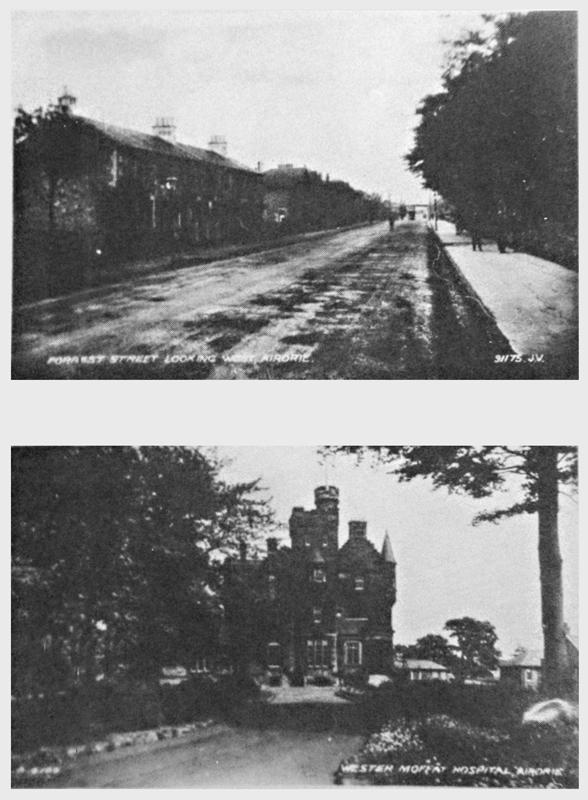
'Dear Allies' by Margaret Henderson | 1988 Monklands District Libraries
Not a single person was refusing to give a signature and Harry Walker believed that the name of every woman in Airdrie and Coatbridge would have appeared, had events not set a time limit to the project:
“Hitler was boasting,” he explained “that the swastika instead of the hammer and sickle would fly over Leningrad and Moscow by Christmas.”

Coatbridge in 'Dear Allies' by Margaret Henderson | 1988 Monklands District Libraries
There were already more than 6000 signatures, headed by the names of the wives of the Provosts of Airdrie and of Coatbridge. Agnes Maxwell and her helpers met to decide how the lists of signatures could be incorporated with the many messages of love and support for the women of Leningrad that had come in from women’s organisations, youth groups, churches of all denominations and local members of the Communist Party. It was suggested by Margaret Plant, an art teacher from Coatbridge, that a decorated album should be made and the committee asked Miss Plant to be responsible for the illustration and binding.
.
As Margaret Plant stayed up late night after night putting the finishing touches to the decoration of the album, requests to sign it were still coming in. Agnes Maxwell was obliged to put a notice in the local newspaper announcing the imminent closure of the appeal for signatures. It was becoming clear that the album should be sent off without delay, for Leningrad was having its coldest winter in a hundred years and deaths from starvation had reached 4000 a day.
.
The housewives’ organisations had already written to the Soviet Embassy in London for advice about the despatch of the album. Madame Agnes Maisky, the wife of the Soviet Ambassador, Ivan Maisky, replied, promising to do all she could to get the album to Leningrad, and suggesting that the women deliver it to her personally at the Embassy. Madame Maisky was a name already well known to the women who were to be presented to her. They knew about her appeals on radio, her visits to factories all over Britain and her friendship with Mrs. Churchill. They had seen photographs of her attending fund-raising galas with her husband.
.
On the evening it was to leave Coatbridge, the women of the committee gathered to see the finished album. They chose a name, ‘The Airdrie and Coatbridge Album’. A deputation of five of them, led by Mrs. Maxwell, was shortly to catch the night train to London. One of them recalled : “Some of the pages with names of factory workers were smudged with grime from the women’s hands. We got a rubber and did the best we could to clean it up a bit before it left on its long journey.”
.
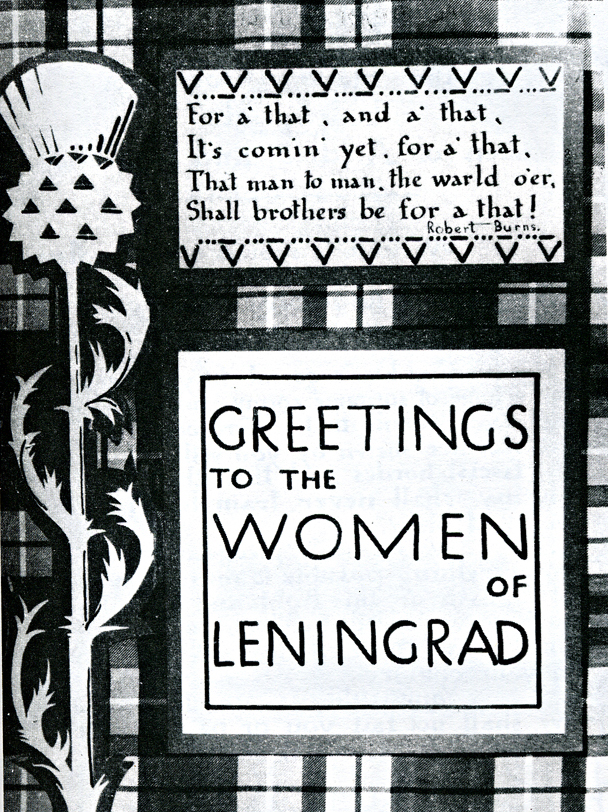
Greetings to the Women of Leningrad - 'Dear Allies' by Margaret Henderson Monklands District Libraries 1988
On Saturday 13th December 1941 the five women were presented to Madame Maisky and the album was handed over with a bouquet of flowers. Madame Maisky read aloud Burns’ “A Man’s a Man, for a’ That “ and spoke about Russia’s struggle. Tea was then served with what Madame Maisky believed to be Scottish scones, but she was not sure and asked for advice on how to bake the real Scottish girdle scone.
.
The women returned home to preparations for another ‘austerity’ Christmas. Shortly after they got back a moving letter of thanks was received from Madame Maisky. They were touched and full of hope. The letter gave them reassurance that there was official recognition of their efforts at the highest level and that every effort would be made to get the Scottish album to its destination.
.
At the beginning of June 1942 – six months after the Airdrie and Coatbridge Album had been delivered to the Embassy – a telegram in a brown envelope arrived at Agnes Maxwell’s home. It was a message from Leningrad, from the Anti-Fascist Committee of Soviet Women.
.
Half a century later, the excitement surrounding the arrival of that telegram remained one of the most vivid recollections of Harry Walker’s life : “It was like something from another world, a miracle.. It was just unbelievable that the women of Leningrad, struggling with hunger and disease and face-to-face with death, should find the time to respond to our pledge of solidarity and admiration. News of the telegram from Leningrad spread from house to house like wildfire. A meeting of the Russia Today Society was arranged immediately. Agnes arrived with the telegram and it was read aloud, then passed from hand to hand. Some of us wept with joy when we read the message :
.
‘Your greeting was received by the women of Leningrad with great enthusiasm. It was read at meetings attended by women workers,teachers, scientists and housewives. The text of a message in reply to Scotland was unanimously adopted at these meetings.’
.
“A message in reply? Perhaps a letter of thanks ? Was it realistic to expect any further news ? The women of Leningrad had received the album; that was what was most important. “
The summer of 1942 passed, the year ended and another year of war began. The promised message had not arrived, but the news from the Leningrad Front was better. On 18th January 1943 a massive assault by the Red Army and civilian defenders of Leningrad had broken through the enemy lines and created a link to the railway, allowing some supplies to reach the city through what came to be known as the ‘Corridor of Death’, under constant shelling and frequent dive-bombing attacks.
.

Madame Maisky christening a Valentine tank in 'Dear Allies' by Margaret Henderson | Monklands District Libraries 1988
On 30th January 1943 a notice appeared in the Airdrie and Coatbridge Advertiser announcing an expected visit by Madame Maisky “to the West of Scotland, some time next week.” The newspaper explained, “ An Album has been received from the women of Leningrad in response to the women of Airdrie and Coatbridge.”
.
But neither of the two towns was on Madame Maisky’s itinerary. It seems that the Ministry of Information was under the misapprehension that the Scottish album had been sent by women in Glasgow. Only through the speedy intervention of Agnes Maxwell were Airdrie and Coatbridge represented at the ceremony arranged for the presentation of the Leningrad Album – in the Glasgow City Chambers. The five women who had travelled to London with the first album were hastily invited.
.
Madame Maisky subsequently had lunch with the Lord Provost of Glasgow who told her that the football used in the New Year’s Day ‘Old Firm’ match between Rangers and Celtic was to be auctioned in aid of the Stalingrad Fund. Her other engagements included visits to ‘a Clyde shipyard’, ‘a West of Scotland war factory’ and the Russian Bookshop in Glasgow. Newsprint was scarce in Britain in 1943, but the Glasgow Herald gave good coverage to the presentation of the Leningrad Album, even describing what Madame Maisky was wearing – ‘a black astrakhan coat with matching hat over a heather-coloured woollen suit.’
.
It was decided that the Leningrad Album would be kept in Glasgow as a token of gratitude to women all over Scotland who were showing such compassion for their Soviet allies. Initially it would be displayed at the Kelvingrove Art Gallery and Museum, at the same time as an exhibition on the contribution of Soviet young people to the defence of their homeland. Then it was to pass into the care of the Mitchell Library, where it remains to this day.
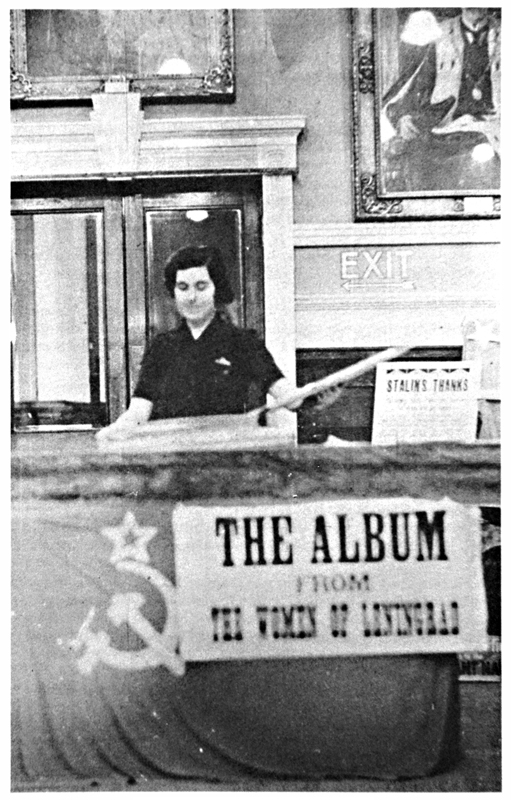
Mrs Agnes Maxwell Examining the Leningrad Album in 'Dear Allies' by Margaret Henderson | Monklands District Libraries 1988
But first, at the request of Madame Maisky, the gift from Leningrad was shown to the people of Airdrie and Coatbridge. The last week of February 1943 had been designated as Russia Week and the centrepiece of an exhibition at the Sir John Wilson Town Hall, Airdrie, was the Leningrad Album. Thousands of local people filed past the Album as the Red Flag of the Soviet Union flew overhead.
.
Harry Walker was there : “Sadness and tears,” he remembered, “mingled with joy and happiness as the pages of the Album were turned, as its beauty was revealed and the feelings of friendship and solidarity it represented were transferred to all who passed by. Many were visibly affected as they examined this unique gift to the people of Airdrie and Coatbridge. Many were heard to remark on the need to speed up the opening of a Second Front to hasten the final defeat of the German Army.”
.
Jean-Claude, Marie-Agnès, Janice, here are some of the heart-felt messages you will find on the beautifully decorated pages of the Leningrad Album. The first one is addressed to the women of Scotland :

Leningrad Album Smolny Institute -'Dear Allies' by Margaret Henderson | 1988 Monklands District Libraries
Dear Allies,
We have been moved to the depths of our souls by the words of love and greeting from those distanced from us in far-off Scotland. We thank you for the help you are giving us in the struggle with Hitler’s Germany. While there is Hitlerism, there is suffering and death – this is the lot of women. Our husbands and brothers are cut off from us, our homes are in danger, our children are doomed to destruction or bondage.
The women of Leningrad, just like the women of Airdrie and Coatbridge, have risen to the defence of their homes, their honour, their independence and their freedom. The ungovernable hatred for the common enemy and the struggle to have revenge on the fascist barbarians for all our suffering, fill our hearts.
We are proud that we have such a worthy ally as the people of Great Britain.
The treaty concluded between our two countries on the 26th May 1942 will give us new strength in the battle with the German aggressors. Rendering one another military assistance and the support of each country in the war with Germany and her allies in Europe, we are coming closer to the not-too-far-distant time when our just cause will win a complete victory.
Dear Allies, we have much ! Women are a great strength. It is up to us to hasten this victory.
We shall do everything to ensure that the year 1942 will be the year of the final rout of Hitler’s armies, the year of liberation of all humanity from the blood-stained nightmare which is Hitlerism !

The Admiralty - 'Dear Allies' - Margaret Henderson - 1988 Monklands District Libraries
To the Girls of Airdrie from the Girls of Leningrad.
Dear Friends,
We send you our warm greeetings. Your undertaking to help us found a warm echo in our hearts. Fascism hangs like a black cloud over our young lives. We do not spare our strength in the name of a splendid future and of life itself, to ensure victory over the hated and inexorable enemy. Hand in hand with you in this struggle, relying on the ever-strengthening unity and help of our states, we will fight for and achieve the right to freedom and happiness.

Barge being pulled along the Neva - 'Dear Allies' Margaret Henderson - 1988 Monklands District Libraries
To the Women of the Co-operative Guild of Coatbridge.
Your friendly letter reached our besieged city and touched us to the depths of our hearts. We thank the women of the Co-operative Guild of Coatbridge for their kind feelings and their wish to help us in the fight we are waging against a common enemy. We are in good spirits and in spite of all the sufferings we have endured, we are holding our ground. Our faith in victory is firm and unshakeable. Together with you, by hard work behind the lines and at the Front, we will achieve victory over fascist Germany.

Lion statue on the embankment of the Neva - Dear Allies - Margaret Henderson -1988 Monklands District Libraries
To Members of the Handwork Circle, Greenfield, Coatbridge.
Dear friends abroad,
We women of Leningrad thank you heartily for your good wishes and messages of sympathy. We are proud of our noble allies, Great Britain and America, and are certain that, by common effort, we shall vanquish the hated enemy, Hitlerite Germany. The future belongs to us because justice is on our side.
(rostrale)
To the Women of the Congregation of Albert Street Church.
We received your greetings and good wishes with great joy. Dear sisters, please believe that we too firmly believe that the day is not far off when our dear ones will return home, when our children will sleep peacefully in their beds, and when aeroplanes with swastikas on them will no longer circle our cities. We Soviet women and you, our dear friends, must do everything we can to make 1942 the year of our joint victory over the enemy. We are sure that you will help us with all your strength and in all possible ways.

View of Canal - 'Dear Allies' - Margaret Henderson - 1988 Monklands District Libraries
Sheets of paper with the signatures of some 3,300 women and girls were placed in large envelopes glued inside the Leningrad Album. The signatories gave their names and their jobs and sometimes described their role in the defence of Leningrad. Many wrote in a shaky hand showing the effects of hunger and physical weakness; some had difficuty with spelling; a few wrote a message in English.
.
In one brown envelope are the signatures of housewives who also described their roles in the defence of the city – messenger, firewatcher, official in charge of a large air raid shelter, member of a house defence committee .. .. .. and of Anastasiya Bogdanova, probably too old to be a defender, who describes herself simply as ‘a pensioner’.
.
The longest lists of names are from the workers at the famous Kirov Factory, the largest industrial enterprise in Leningrad, where the workforce then consisted overwhelmingly of women and young girls. All the members of the First Aid team signed the album; the members of the Workers’ Social Club all signed, among them machine operators, cleaners, directors and an engineer who proudly described herself as ‘a Stakhanovite.’ Other women described themselves as ‘armed guards at the Kirov’ or simply ‘fighters’. There are signatures of an apprentice lathe operator; a foundry mechanic, an instructor in hygiene, a crane operator .. ..
.
A school exercise book with squared paper and multiplication tables on the back cover contains the signatures of primary school teachers, a school inspector and the director of a children’s home. The album was taken to several hospitals in Leningrad including the Military Hospital No.1 where the commandant and all the doctors signed, most of them in the illegible handwriting characteristic of the medical profession the world over.
.
Women prominent in the artistic and intellectual life of Leningrad wrote their names, among them Yelena Deymeke, a writer of film scripts; Antonina Lebedeva, an opera producer and acting director of the Conservatoire; Maria Ovchinnikova, the director of the Instutute of Oriental Studies; and Jane Kolpakchy, professor of Japanese at Leningrad University.
.
The album was taken to the Leningrad Theatre of Musical Comedy where it was signed by the famous and dearly loved ballerina, Nina Peltser and her colleagues. The theatre remained open throughout the Siege.
In a conversation in the 1980’s, Nina Peltser recalled : “The auditorium, seating 1300, was always full. There were queues before every performance. And the best workers in factories were given tickets as a kind of reward. When people are weak and hungry, toes go numb first, but in ballet you have to dance on your toes and we did it. In winter our comrades would wait for us in the wings with sheepskin coats and as soon as a dancer had finished she would be wrapped in a coat and taken to a burgeuika, a small stove made of metal. She would be warmed up and then come fluttering back, just as if there were no war. In the wings dancers would fall down exhausted, but on the stage all was merriment, the orchestra thundered and everything went on as it should in an operetta.
.
“As well as the familiar productions the audience loved, the company put on twenty new productions in the years of the Siege. The final rehearsals were in progress for one of these, A True Story of the Woodlands, when they came collecting signatures for the Leningrad Album. Some new theatrical companies were formed during the Siege” she added , “the Blockade Theatre, for example. In the album you can see the signature of its Director.”

Anna Petrovna-Ostrounova-Lebedeva - Dear Allies - Margaret Henderson-1988 Monklands District Libraries
.
Anna Petrovna-Lebedeva, one of the most distinguished artists in Leningrad, was in charge of illustrating the Leningrad Album. She was assisted in putting the album together by a collective of artists. Anna Petrovna-Lebedeva was born in 1871 in St Petersburg and died in her native city in 1955. She was a painter in watercolours and a wood engraver, one of the leaders of the Russian revival of creative wood engraving ( in which an artist executed both the drawing and the engraving, the latter traditionally having been the province of craftsmen). She was one of the first members of the Society of the World of Art founded by Sergey Diaghilev and Alexander Benois. But it was her series of colour prints of Leningrad – from which the illustrations in the Leningrad Album were selected – that brought her worldwide fame. Soon after the War she was elected a member of the Academy of Art of the USSR and received the title of People’s Artist. But of her many awards, the one she was to cherish most was the Medal for the Defence of Leningrad.

Medal for the Defense of Leningrad - Source: Wikipedia
.
The address of Anna Ostroumova-Lebedeva’s house, where the Leningrad Album was created, is 10 Academician Lebedev Street – in the famous Vyborg district whose working-class population played a leading part in the Revolutionary struggle. She was 70 years of age at the outbreak of war, but she was one of the most productive artists of the Siege, often to be seen sketching on the banks of the River Neva when there was a lull in the bombardment of the city. People were heartened to catch sight of one of the ‘real artists’, as they were called in Leningrad, who struggled to transform the human tragedies and triumphs of these years into paintings, music or literature.
.
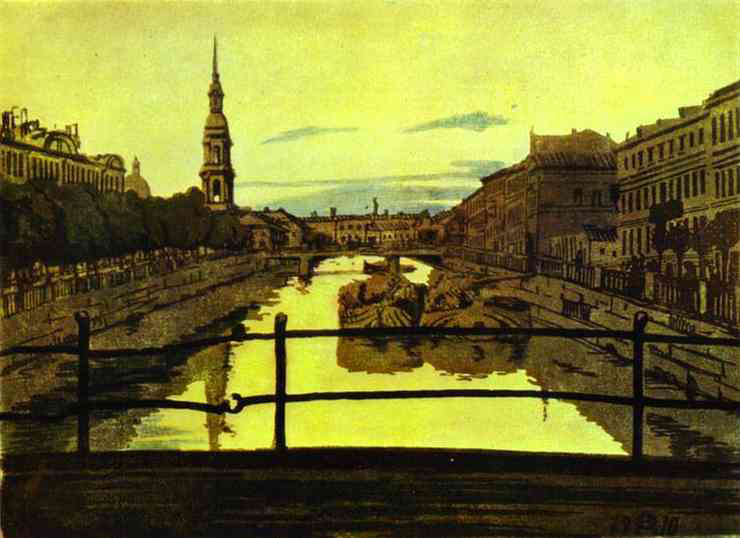
Anna Ostroumova-Lebedeva View of Canal 1910 - Colored woodcut - Source: http://www.abcgallery.com/O/ostroumova/ostroumova.html - Olga's Gallery
.
One day in the summer of 1942 Anna Ostroumova-Lebedeva was taken to the office of the City Party Committee where she was shown the album which had arrived from Scotland with greetings and good wishes to the women of Leningrad. It had been decided that an album would be sent in reply and Anna was asked if she woud undertake the project with other artists. Delighted, she agreed immediately, suggesting that the work could be done in her home, at her favourite birchwood table.
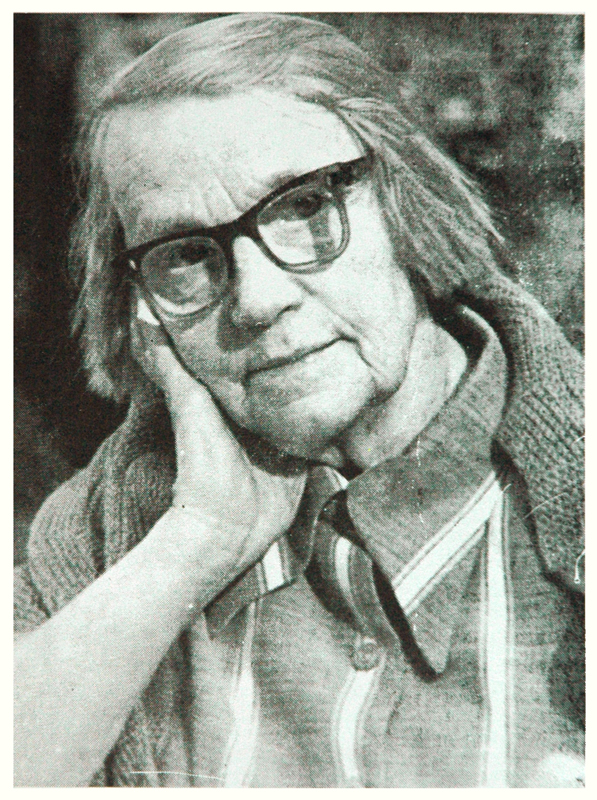
Vera Milyutina -1987 Soviet Banner -Dear Allies -Margaret Henderson -1988 Monklands District Libraries
.
One of the collective of artists was a young, relatively unknown woman,Vera Vladimirovna Milyutina, who kept daily memoirs of the Siege of Leningrad. She recalled being summoned to help with the Leningrad Album : “After the incredibly difficult first winter of the war, hungry, cold and dark, at last the spring of 1942. The weather become warmer, but the people of Leningrad were just as hungry as before and still trembling with inner cold. It was impossible to get warm, even in the sun. Our legs felt as if they were made of cotton wool and our fingers would not obey us properly.
“Then, on 13th June 1942, I had a visit at my home from Andrey Andreyevich Bartshevich, an official in the Commission for the Arts. He told me that we must help our famous artist, Anna Petrovna Ostroumova-Lebedeva.”
.
Vera did not have far to go. Mrs. Ostroumova-Lebedeva’s house was in the same street as the house Vera shared with her grandfather. “This is what she told us,” explained Vera in her memoirs. “At the end of 1941, women in Scotland who were full of sympathy for the difficulties of the women of the blockaded city of Leningrad had the noble idea of sending expressions of sympathy and encouragement to them.
“The touching drawings in the album they sent from Scotland were done with great care and love. The binding was of silk tartan in traditional colours of orange, white, cream and yellow, across which was laid the flower of the thistle, the emblem of Scotland. “
.
Vera continued : “Andrey Andreyevich asked me whether I had the strength to take part in a very responsible and urgent matter – the creation of an album as a gift to the women of Scotland.”
Vera and Andrey Andreyevich went together to 10 Lebedev Street where the great artist stayed with a companion, Anna Matveyevna ,whom she called ‘Nyusha.’
.
“The flat was clean and well-kept,” Vera remembered, “but the building was damaged and the house was also threatened by the overhanging ruins of a six-storey building with a grotesquely distorted bath and bent piping visible, and sheets of iron waving about in the wind.I was wearing my high Russian boots, having just changed out of the men’s clothes I had been wearing for so many months. I was unrecognizably thin, frozen by some sort of inner iciness. By that time hunger had marked us all, making us hideously similar. Even though our rations had slightly increased, it was at that particular point of the siege that Leningraders acquired this quite terrifying appearance.
.
“Everyone was suffering from vitamin deficiency, scurvy and anaemia. Our fingers lacked agility and our eyes clarity of vision, our brains tired easily. We were hungry but we had no time to go for our meagre rations (a plate of soup and a little porridge). Anna’s friend Nyusha would heat the samovar with a few bits of wood and after a glass of hot water, work went much more easily. One of the graphic artists , Boris Petrovich Svetlitskiy, spent the whole of one of the ‘white nights’ sitting at a desk writing out the text in longhand. My job was to combine the design of the pages of the album into a whole, to execute the numerous graphic designs on various pages and to create the compositions for the fly-leaves made up of the flags and coats of arms of the USSR and Great Britain.
.
“After working for several hours, my eyes couldn’t see any more. I would return to my bombed, partially burned-out home. My grandfather would come back from his work and we would sit down to a meal of thin broth and a galantine made of carpenter’s glue and bay-leaves. The others in the group lived too far away to go home for something to eat. I offered to pick some grass for them.
.
“It fell to me to find the information for the album about British flags. Our encyclopedia had only black and white pictures but we knew that the Library of the Academy of Sciences had them in colour. I set out to walk to the library across the empty city, so greatly changed. Though I used a walking stick, I had to rest frequently, sitting down on doorsteps or heaps of rubble. Then it was so hard to get up and start again .. ..
.
“Once I came upon an acacia tree in full bloom, behind cast-iron railings. I started to eat its yellow flowers, savouring the bitter taste. I couldn’t tear myself away from it until I had eaten every single flower.
At last I reached the library. I asked the authorities if I could see the British flags and crests. They told me that information was held on the second floor but each member of the library staff had already climbed the stairs that day and no-one had enough strength left to go up again. I told them how far I had walked and that the information was wanted urgently for an important purpose, but I couldn’t persuade them. ‘Come back tomorrow,’ was the reply. ‘Tomorrow someone will go to the second floor. There is no-one who can climb the staircase again today.’
“The next day I set out at dawn on the same journey for a second time. They showed me to a desk in the empty second floor reference room and I was so happy to find all the information I needed!
.
“In five days we had completed the Leningrad Album, five days of hard, mostly silent work, exhausting but so satisfying ! It had grown into a large, handsome book, each page measuring 30 by 40 centimetres. It was made up in a beautifully professional way. Its pages were decorated with water-colours and tinted and black and white prints, mainly the work of Anna Ostroumova-Lebedeva and some other artists whose names I don’t remember. The coats of arms of the USSR and Great Britain were exact in their proportions and colouring. They were painted in exuberant Baroque style, decorated with gold and silver, with numerous lions, unicorns, leopards, crowns, knights and shields, on intertwined pale blue ribbons, with the rose of England and the thistle of Scotland.
.
“On the thick linen binding of the album we mounted a fine early Russian embroidery which Anna Ostroumova-Lebedeva had selected from the reserve collection of the Russian Museum. We placed the album in a box-like case which we covered with a gold brocade. The left-hand pages were fitted with pouches in which we placed the sheets of paper containing the signatures of the women of Leningrad.
The Commission for the Arts and the Smolny* authorities approved the album and it was immediately flown to Moscow. From there it was conveyed to London.”
.
(*The Smolny was the administrative and military headquarters of Leningrad during the Siege.)
.
Vera Milyutina was among the artists, some already famous, who struggled to get to the Hermitage to record for posterity the damage done to the building by shells and bombs. A year after her death in 1986 Vera Milyutina’s ‘Hermitage Collection’ was shown at a memorial exhibition of her paintings on the 43rd anniversary of the lifting of the Siege. At the end of the evening a former pupil approached Vera’s husband with a note the celebrated artist had written to her at the height of the Siege :
.
‘We need real art, art which makes one’s heart sing, which makes one so happy one floats above the earth. Colour and sound blend and fill the world.
The hard, terrible times will pass away. Life will be easier.’
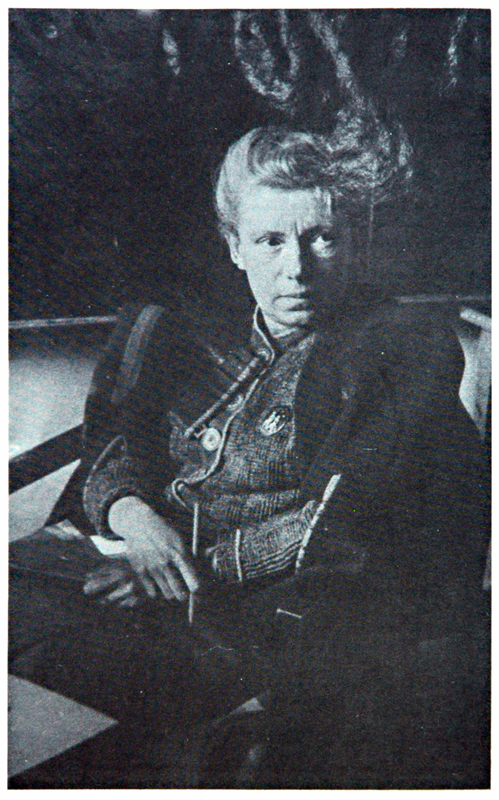
Vera Inber -Dear Allies -Margaret Henderson -1988 Monklands District Libraries
.
The last message in the Leningrad Album is a poem written for the women of Airdrie and Coatbridge by the distinguished poet Vera Mikhaylovna Inber. During the Siege of Leningrad Vera Inber produced two major works considered to be among the most moving literary evocations of the war years; an epic poem – for which she received a Stalin prize – and a diary entitled Almost Three Years. She and her husband, a professor of medicine, had moved from Moscow just before Leningrad was encircled. They chose to stay. Vera Inber believed it was her duty as a much-read Russian poet to experience and record the worst sufferings of her people.
.

Leningrad Imperial Academy of Arts, Russia - Source: Wikipedia
.
The messages in the Leningrad Album to the women of Airdrie and Coatbidge were clearly a warm and spontaneous expression of the Leningrad women’s happiness on learning that they were in the thoughts of so many well-wishers in far-away Scotland. But the high artistic standard of the album and the care devoted to its presentation had a deeper significance.
One of the great sources of pride for Leningraders who survived the Siege was to look back and know that they had managed to keep alive, even in the darkest days of their ordeal, the musical and theatrical performances, the literature and art of a city which had been renowned for its cultural life for two centuries.
The writers and artists and composers of the Siege produced a whole body of work later to be known as the Literature of the Blockade, the Art of the Blockade and the Music of the Blockade. These works shone with a clarity of vision that only their creators’ journeys to the limits of human endurance could have revealed to them. Leningrad had risen above the worst the enemy could do to degrade the human spirit.
.
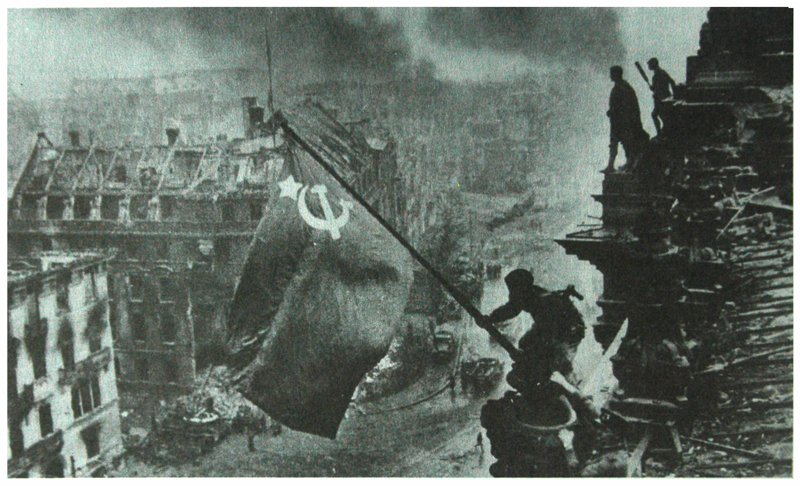
Soviet Banner - Dear Allies - Margaret Henderson - 1988 Monklands District Libraries
.
.
Copyright Margaret Henderson, 2011.
………………………………………………………………………………………………………………………………………….
The successor to Monklands District Council is North Lanarkshire Council, based at Motherwell. Enquiries regarding Margaret Henderson’s book, ‘Dear Allies’, should be addressed to:
Mr Andrew Edgar, North Lanarkshire Libraries, Coatbridge Library, 126 Main St., COATBRIDGE.
………………………………………………………………………………………………………………………………………….
Chers Amis, we hope you’ve enjoyed this long Letter from Scotland!
A bientôt,
Margaret, Iain.


































[…] Scotiana […]
A fantastic work of art and beauty produced by courageous women at a very difficult time.
Showing that the fight against facism from the heart and soul of these people in desperate
circumstances was so strong.
This is close to my heart, being a native Scot with Russian children, both born in Moscow. I am also an English teacher and currently do a weekly speaking group via Zoom with Russian students, mostly women. The beauty of what the Scottish women did for the people of Leningrad goes beyond acts of kindness and solidarity.